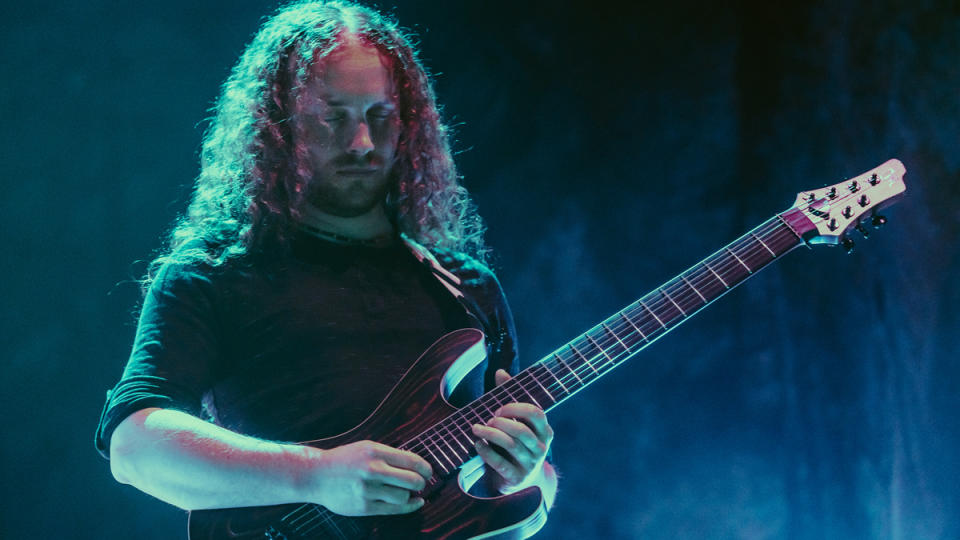“Shredding over the top is what all prog-metal does – we have a Pink Floyd approach to lead rather than John Petrucci”: Nobody djents like TesseracT – and two decades in, the tech-metal heroes are making their most mind-bendingly intricate riffs yet

It’s been half a decade since the British titans of prog-metal last gifted us with a new studio album. In the intervening years, interest in technically astounding progressive guitar music has boomed, with artists like Polyphia, Plini and Jakub Zytecki leading the new-school charge. But, as TesseracT return this September with War of Being – a high-concept, low-strung beast of an LP – their position as leaders in the cerebral guitar space remains in rock-solid stead.
With nine tracks stretching to over an hour's worth of seven-string adventures, War of Being absolutely dwarfs 2018’s Sonder in size and scope – just as its 11-minute odyssey of a teaser single seemed to promise it would.
Stuffed with gargantuan unison riffs, tasty thump flourishes and a slew of nimble alternate-picking routines performed by guitarists Acle Kahney and James Monteith, it’s a veritable feast of djent-flavored ear candy that will no doubt sate those who have been hungry for new tunes for five long years.
We caught up with Acle and James on the eve of the album’s release – while the pair are deep in preparation for their upcoming US tour – to chat guitars and gear, mastering the art of “stupid” time signatures and why they’ve “never really got into shreddy solos” and probably never will.
But first, in this age of algorithm-curated playlists and dwindling attention spans, how exactly does a band get away with dropping such a whopper of a lead single, anyway?
“War of Being wasn’t intended to be an 11 minute song; that just came by accident,” laughs Acle. “I think it came from the fact that I had a two minute idea for the first bit and didn’t know what to do with it. Eventually, just by drilling things and looping them forever, a little seed of an idea will come and I’ll find two bits that link because they might be in the same tempo or key or something. So, six months later, I’d written another section and pieced that together. Then another six months later, the third bit.”
“Describing it like that sounds like it’s a riff salad,” he adds with a smile. “But hopefully it’s not and it’s got some form and structure to it.”
Form and structure, in fact, are where TesseracT excel, and their latest offering is best absorbed in one sitting in order to fully appreciate the full scope of the arrangements that swing between David Gilmour-inspired light and thunderous Meshuggah-esque shade – two of Acle’s biggest musical inspirations. Songs like Natural Disaster and The Grey are classic TesseracT, while the likes of Burden and Legion incorporate sparser, cleaner and more melodic sensibilities. None of them run for less than six minutes.
In the hands of many of their contemporaries, such expansive songs would also mean expansive solos and plenty of ‘em. But that isn’t the case here – in fact, shredding, tapping or setting up camp at the far reaches of the fretboard has never really been TesseracT’s style. “I just hate solos,” shrugs Acle by way of a concise explanation.
“I don’t think the music really calls for it necessarily because a lot of it is about interweaving melodies and interesting stuff like that,” adds James. “[Shredding] over the top is kind of what all prog-metal does and I guess this is a bit more of a Pink Floyd approach to lead rather than John Petrucci.”
Their shunning of this particular type of in-your-face showboatery encourages us take in both the macro vision of the album as a whole and to savor the micro details that have been baked into individual songs. For example, both Acle and James describe those repeating bends in War of Being as one of the most challenging parts on the album to perfect, but they’re no doubt one of its standout guitar refrains.

“It’s just getting those little bends between me, James and Amos [Williams, bassist] in tune and in sync,” explains Acle. ”It’s such a subtle little bend and it can quite easily go horribly wrong.”
“A lot of work had to be put into that just to get it good enough to jam in a bedroom, let alone actually on stage,” adds James, who’s used to being tasked with learning lots of tricky material devised by Acle (“the mastermind” behind 80-95 percent of TesseracT’s instrumental composition). Both, however, report that the creative process was generally more of a collaborative effort this time around.
A TesseracT album also wouldn’t be a TesseracT album without some killer polyrhythmic workouts and voyages into uncommon time signatures, and there are no disappointments in this department. When asked whether their ability to think outside the rhythmic box relies more on rigorous counting or just “feeling” any given groove, the pair have some reassuring news for anyone who's ever gotten bogged down in the mathematics of it all.
“It’s the latter,” verifies Acle. “95 percent of the time, it’s about just getting a pulse and nodding to it.”
“When you’re trying to play this stuff, it’s actually a case of throwing counting out the window,” adds James. “It’s all about understanding the pattern, locking into the pattern and grooving it and just getting used to playing things that don’t loop around four. I guess lots of us get stuck in that rut. Lots of musicians get stuck in looping in three or four, but when you start thinking in other numbers or other phrases and you get your head round it, it’s actually not that different.”
In rare instances when a groove is counter-intuitive even to them, they’ll enlist a little help with the timekeeping. Sirens, for example, has an end section that Acle describes as “just weird,” and so he deploys automated cues to keep everyone on track during live performances.
“It’s in some stupid time signature, which wasn’t a conscious thing when writing it,” he explains. “While trying to learn it and practice for the upcoming tour, I’ve had to put in cues and this voice going: ‘One, two, three, four, five, six, sev-, one, two…’ with a little push, because if I try and do that and play it I don’t know where the hell I am.”
As James puts it: “It’s not really us counting ourselves; it’s the computer saying: ‘Now play here!’”
When it comes to the tools of their trade, Acle tends to rely on his trusty Mayones Setius AK1 seven-string signature model, which has a 27-inch scale length and is loaded with Bare Knuckle Black Hawk humbuckers to provide the “articulation and tight bottom-end” so crucial to his sound.
James, a long-time user of Ibanez guitars, will typically either reach for his green and black LACS custom shop seven-string – which is based on the RGD, but with some mods – or a black RGD Uppercut (RGD7UCS) fitted with Bare Knuckle Aftermaths. “I feel like Bare Knuckle are really good with the lower-register single-string notes,” he effuses. “You really get the cut through and they’re articulate down there more so than others. Basically, if you want to rip off Meshuggah, they’re very good.”

Since completing the album, he’s also become enamored with a stock Ibanez RGD3127 that he says “plays brilliantly”, thanks to its smooth maple fretboard, and reveals that he’ll soon be receiving another new guitar from the good folks at the Ibanez LA Custom Shop inspired by it.
An interesting quirk of James’ guitars is that they’ll usually be adorned with strips of luminous tape just above the nut and below the bridge. So, we ask, what’s that all about?
“It's me basically being a cheapskate,” he laughs. “I guess the proper thing to do would be to get one of those foam dampeners, but it’s basically to stop ringing, and stop the resonance from there that the pickups can kind of pick up and make noise when you’re trying to play tight.” It’s a handy hack to know by all accounts.
The pair are also both longtime converts to the worlds of amp modeling and profiling technology, having adopted Axe-Fz in the early days, before switching to Kempers around the time of Sonder.
“We’ve moved over to the Neural DSP Quad Cortexes now,” says Acle, who’s recently consolidated every tone worth keeping from over the years and from across projects into these new, ultra-powerful devices. “It’s just nice to have everything in one tiny little unit that weighs about two kilograms,” he adds. “For flight gigs, it’s really useful.”
Although James describes the EVH 5150 III he keeps at home as “literally just the most fun thing to play in the world,” it’s unlikely that they’ll be taking any real amps out on the road with them any time soon.
”It’s not that practical for this kind of thing,” he acknowledges. “There’s so many patches, so many sounds, so many tempos for delays and so much stuff that to do it any other way [than with the Quad Cortexes] would be really, really complicated.”
Digital amps also offer a different dynamic response, which is particularly critical when you’re in the business of hyper-tight riff craft, as these guys are.
“We tried out a Diezel VH4 for a couple of days when I was doing some amp tone hunts while tracking the album,” recalls Acle as a case in point. “It does sound nice and I love it, but as soon as you start doing that weird “djenty” intricate stuff – the really tight scratchy stuff – it’s quite slow to respond compared with a digital thing and I’ve just got used to that.”
With the Quad Cortexes taking care of just about everything else, the only pedals James and Acle require at their feet are tuners. “Posh” Peterson StroboStomps are where it’s at, according to James, if you’re looking for extreme levels of accuracy. “The Boss ones are absolutely fine for most things,” he weighs up. “But we’ve become so incredibly anal with tuning that these help you be, umm, more anal!”
War of Being is out now via Kscope. TesseracT tour the US from October 2023 – see TesseractBand.com for full dates.

